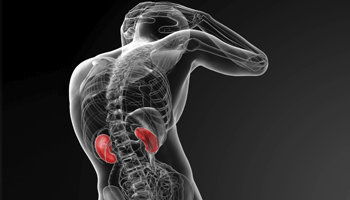23.10.2014
Feat of strength in maintaining stability: all in a day’s work for the kidney
A bathtubful of water and a kilo of salt make up the daily metabolic turnover of the human kidney. If the reabsorption of water and substrates gets out of control, then blood pressure stability and fluid balance begin to fluctuate. A study by the Department of Medicine of the University of Fribourg has now shown that the reabsorption of water from the urine into the bloodstream is far more sensitively regulated than was previously assumed. It is a mechanism which plays a central role in the human body.

(Image: Thinkstock)
It is of great interest to be able to understand how the kidney accomplishes the immense daily task of reabsorbing about 159 litres of water (a bathtubful) and about 900g of salt in order to maintain blood pressure stability and fluid balance. Clinical symptoms which appear when this renal function fails represent a drastic reduction in general wellbeing for the patient; in the long term, secondary complications can arise, i.e. damage to organs in the entire body. The present study by the Department of Medicine of the University of Fribourg shows that the reabsorption of water, that is, the return of water from the urine to the bloodstream, is precisely regulated in a particular section of the kidney depending on vascular circulation. This discovery replaces the long-held hypothesis of the presence of a continually active (constitutive) movement of water via the kidney.
Everything flows – but not unchecked
One of the main tasks of the kidney is maintaining a constant volume of circulating blood. If the kidney only performs this task partially or not at all, this can cause blood pressure to be too high or too low or cause fluid to be deposited in tissue, giving rise to so-called edema. Every day roughly 160 litres of water as well as a quantity of dissolved substances, such as about 1 kilo of salt and vitally necessary proteins, pass through the so-called blood-urine barrier via the kidney and are reduced by means of a specially structured system of tubes down to small quantities for excretion. In order to maintain a balance between blood volume and blood pressure (homeostasis), the first section of this tube system reabsorbs the greatest part. This section also contains the Aquaporin-1 water channel. This water channel is responsible for allowing the water to flow through the cell’s lipid membranes so that it can re-enter the bloodstream. Since hormones important for the regulation of the osmotic pressure of body fluids (osmoregulation) were seen to have no effect on this channel, it was believed for a long time that the latter was constitutive and thus did not adjust to changed conditions in its surroundings.
The research results of Prof. Franziska Theilig’s group have now shown that a change in the rate of flow of the as yet unconcentrated primary urine sends a signal to the cell which causes increased Aquaporin-1 to be built into the cell membrane. This is achieved by cellular redistribution of Aquaporin-1 from an intra-cellular pool into the membrane and by the channel being made more resistant through changed protein marking, thus reducing its degradation. Within a few minutes, this mechanism can bring about a short-term doubling of the flow of water through the cell and accordingly drastically increase the reabsorption into the blood. This rapid adjustment to changed local conditions can also be seen in other organs, for example the brain, where Aquaporin-1 plays a role in the production of brain fluid and the local development of edema. Knowing how this regulation takes place could in future offer pharmaceutical methods of stopping the leakage or flow of liquids, thus preventing clinical complications such as the increased accumulation of water (as, for example, in edema and high blood or fluid pressure).
Publication:
Short-Term Functional Adaptation of Aquaporin-1 Surface Expression in the Proximal Tubule, a Component of Glomerulotubular Balance.
Pohl M, Shan Q, Petsch T, Styp-Rekowska B, Matthey P, Bleich M, Bachmann S, Theilig F.
J Am Soc Nephrol. 2014 Sep 30. pii: ASN.2014020148. [Epub ahead of print
Link: http://www.ncbi.nlm.nih.gov/pubmed/25270072
Contact:
Prof. Franziska Theilig, Department of Medicine, franziska.theilig@unifr.ch, 026 300 85 47
